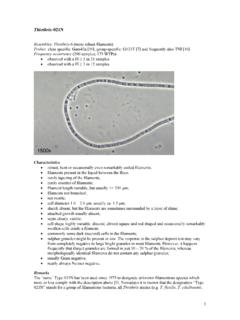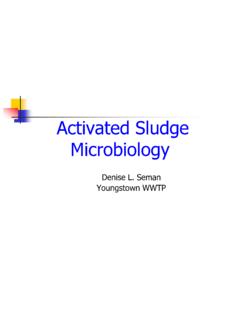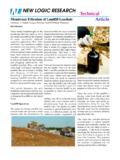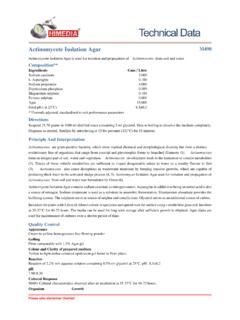Transcription of Type 0041 - Activated sludge
1 1 Type 0041 Resembles: see remarks Probes: some affiliate to the Candidate division TM7 [4], see remarks Frequency occurrence (200 samples; 175 WTPs): observed with a FI 1 in 93 samples observed with a FI 3 in 8 samples With attached growth Without attached growth Characteristics straight or bent filaments; filaments protruding from the flocs or free in the water phase between the flocs; not motile; not branched; filament length variable; cell diameter - m; sheath present; attached growth might be present; septa visible if massive attached growth is lacking; almost square cells; no sulphur storage; occasional small dark granules present; Gram positive.
2 Filaments, however, stain sometimes dotted blue with Gram and parts of filaments which are surrounded by massive attached growth might stain Gram negative; Neisser negative. Remarks 1. Type 0041 is especially characterized by its Gram positive, ensheathed filaments which are composed of almost square cells with a diameter varying from m to m. Massive attached growth might be present. Contrary to domestic WTPs, where usually just one morphotype occurs meeting this description, a number of Type 0041 resembling morphotypes have been observed in industrial WTPs, which extremely complicates identification and classification based on morphological features.
3 This table shows which Type 0041 resembling morphotypes are included on this CD-ROM. Morphotype Main differences with Type 0041 Type IF-4 rectangular cells and dark bands along the septa Type IF-5 perpendicular attached growth and probe CFX-1223 positive Type IF-6 tip of the filament protrudes from the sheath Type IF-15 m in diameter and probe CFX-1223 positive Type IF-23 bright appearance and occasionally tangled filaments 2 Type IF-32 long, tangled filaments, somewhat resembling Type 0803 Type IF-68 relatively thin, long.
4 Tangled filaments with heavily attached growth Type IF-51 Gram negative Type IF-54 Gram negative and septa hardly visible 2. Unfortunately, species-specific probes are not yet available. The probes TM7-305, specific for the TM7 Division [4] and CFX-1223, specific for the Chloroflexi [2] were applied during the Dynafilm research program. If a FISH signal was obtained with probe TM7, the fluorescent filaments indeed often resembled Type 0041 . However, in many other sludges, with Type 0041 resembling filaments, no fluorescent signal at all was obtained with probe TM7.
5 Characteristic Type 0041 filaments occasionally gave a signal with probe CFX-1223. The more robust morphotypes Type IF-5 and 15 gave, on the contrary, a fluorescent signal with this probe in many sludges. 3. Type 0041 filaments can be mistaken for those of S. natans (Gram negative and rectangular cells) or for some Thiothrix species (S granules and Gram negative). Thin Type 0041 filaments resemble those of Type 1851 (pale blue with Gram and long, rectangular cells). Aquaspirillum-related filaments [9] , targeted by probe Aqs-997, sometimes also resemble Type 0041 .
6 4. It is evident that solving the Type 0041 puzzle will require much more investigation. Physiology MAR studies revealed that Type 0041 resembling filaments [1] and probe TM7-305 positive filaments [8] mainly used simple sugars such as glucose or mannose for their growth. The results obtained with glycine, leucine and oleic acid were not consistent and acetate was not taken up at all by the filaments. Sugars were taken up under aerobic as well as under anoxic conditions, which implies that TM7-305 positive filaments can grow under denitrifying conditions.
7 Occurrence in Activated sludge Larger populations of Type 0041 were observed in WTPs treating wastewater from the pulp & paper, potato, textile, sugar, chemical and food industries. Thus, it is not possible to correlate this filamentous morphotype with a specific wastewater. Control options The common possibilities aimed at solving a bulking problem are listed below (1-7). Type 0041 was effectively controlled by applying an aerobic selector in several WTPs, but the published results on this subject are not always consistent.
8 Developing strategies aimed controlling in a more systematic way members of the Type 0041 group will not be possible until their phylogenetic affiliation is resolved and probes for their in situ detection have been developed. It is always recommended to start with a pilot scale experiment before a selected control method is applied on full scale. References for further reading: 3, 5, 6 and 7. 1. Good "House-keeping". 2. Remove deficiencies: O2 > 2 mg/l and BOD:N:P =100:5:1. 3. Two step configuration (aerobic/aerobic or anaerobic/aerobic), in order to remove largely the easily degradable influent fraction before this enters the aeration tank.
9 4. Aerobic selector. 5. Anoxic zone if sufficient nitrite/nitrate is available for removal of the dissolved fraction from the influent through denitrification. 6. Anaerobic zone if a combination with a Bio-P process is an option. 7. Controlling symptoms, viz. applying physical or chemical methods aimed at destroying the filaments or at improving the settling velocity of the flocs by increasing their weight. 3 References 1. Andreasen, K. and (1997) Application of microautoradiography to the study of substrate uptake by filamentous microorganisms in Activated sludge .
10 Appl. Environ. Microbiol. 63, 3662-3668. 2. Bj rnsson, L., P. Hugenholtz, and Blackall (2002) Filamentous Chloroflexi (green non-sulfur bacteria) are abundant in wastewater treatment processes with biological nutrient removal. Microbiology 148, 2309-2318. 3. Eikelboom, D. H. (2000) Process control of Activated sludge plants by microscopic investigation. IWA Publishing, London, UK. 4. Hugenholtz, P., Tyson, Webb, Wagner and Blackall (2001) Investigation of candidate division TM7, a recently recognized major lineage of the domain Bacteria with no known pure-culture representatives.






